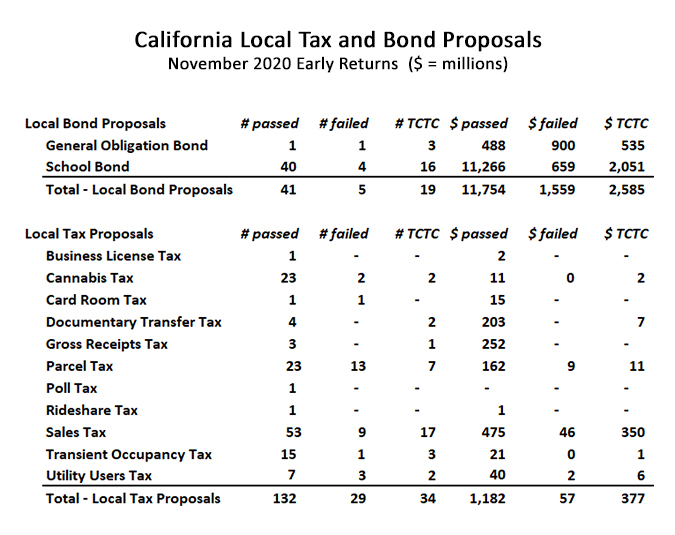Billions in Local Taxes and Borrowing & The Dangers of Direct Democracy – CPC Newsletter
California voters approve billions in local taxes and borrowing: In his latest analysis, CPC contributor Edward Ring summarizes the results of California’s local tax and bond proposals on last week’s ballot. He highlights how the broad support for local tax and bond measures contrasts with the opposition to similar measures in the March 2020 election, which offered a promising rebuke to unchecked government union power:
Early returns from the November 2020 ballot show Californians have snapped back towards approving the vast majority of new local taxes and borrowing. As shown in the table below, of the 46 proposals to issue new bonds that have been decided so far, 89 percent passed, and of the 161 proposals to raise local taxes that have already been decided, 82 percent passed.

*TCTC = Too close to call.
Prop 15 defeat holds: On Tuesday, the Associated Press confirmed that Prop. 15 failed to pass, falling short by about 600,000 votes, with 48.2 percent in favor and 51.8 percent opposed. The victory protects small businesses – as well as their employees and customers – from massive property tax increases backed by government unions, especially the California Teachers Association and SEIU, which spent a combined $30 million on the effort. Most inland counties opposed the measure by 20 percentage points or more.
California is the specter haunting America: On this week’s episode of National Review’s Radio Free California, CPC President Will Swaim and board member David Bahnsen discuss the Biden team’s bottomless affection for policies tested and failed in California. They ask who Gavin Newsom will name to fill the Senate vacuum created by Kamala Harris’s rapid rise, and wonder why California’s political elites hurt the working class they say they love so much.
California’s one-party rule is coming for the rest of the nation: In a piece for The Federalist this week, Katya Sedgwick argues that California is a coming attraction for the rest of the nation. As Will has also argued (using the same drug metaphor), Katya notes that the forthcoming federal bailout will merely paper over the significant structural problems facing California’s economy:
While Kamala may direct federal money to our near-bankrupt state that took months of lockdown pain to keep economic activity down to ensure a mail-in election, a federal rescue package is unlikely to affect our quality of life: it won’t put the junkies into rehab or punish criminals. Nor will it stop the forest fires, for that matter, or create economic opportunities in an overregulated environment. It will function as a kind of needle exchange, like the “harm reduction” policy popular with local politicians, except not for the strung-out addicts but for the terminally dysfunctional technocratic machine. Bailouts may keep the state alive in the immediate future, hoping against hope that deep structural problems will magically resolve themselves, but in effect prolonging suffering for everyone.
Pandemic pod pushback: In his latest analysis, CPC contributor Larry Sand highlights union efforts to restrict the growing pod learning movement, where families group together to form their own micro-schools:
As the education establishment ramps up its efforts maintain its monopoly status, the numbers are not looking good for them. According to an EdChoice poll, learning pods are booming nationally, with 35 percent of parents claiming they currently participate in a pod, and another 18 percent of parents are interested in joining one.
Californians need school choice, not affirmative action: In an OC Register op-ed this week, the Cato Institute’s Neil McCluskey and Solomon Chen explain why school choice is a far better way to help minorities than the recent failed attempt at reinstating affirmative action:
Affirmative action would not have addressed the much more fundamental barrier to Black and Latino success: too few K-12 options to prepare them for college…. Improving educational attainment is a crucial goal, but affirmative action in college admissions would apply only after substantive inequalities had already taken their toll. The California Department of Education reports that in 2019, only 44.1 percent of graduating seniors were deemed prepared for college or postsecondary careers, with even lower rates for Latino (36.1 percent) and African-American (23.7 percent) students…. Giving underrepresented minorities increased choice both of public and private schools would better empower them to access, and flourish in, higher education.
Another member of the 1% departs: This week, tech entrepreneur Joe Lonsdale, who co-founded the software giant Palantir Technologies, announced that he’s moved his venture capital firm 8VC from California to Texas. Lonsdale, who now calls himself “a proud Texan,” said, “Texas is a lot like going to California 40 to 50 years ago. It’s very welcoming, it’s a dynamic economy, it’s affordable.” He noted that Texas surpasses California “in almost every method you can name, whether it’s education, pollution, homeless.”
The dangers of direct democracy: California’s ballot measure system has provided a vital check on the state legislature’s big government ideology. But let’s close this long proposition season with a brief philosophical look at the dangers of direct democracy, namely, its threat to Californians’ individual rights.
Prop 15’s victory to keep Prop 13’s tax protections in place is great. But tax-increase proponents will almost certainly be back with another referendum in 2022 to try their luck again. Given how close the results were this year, it seems like only a matter of time before they succeed. With unlimited at-bats, almost anyone can hit a home run.
It seems unfair that voters can reject several efforts to overturn Prop 13’s protections, only to see them disappear from an especially well-funded or lucky ballot measure victory in the years to come. If voters pass a version of Prop 15 in 2022, shouldn’t there be some sort of rubber match to determine whether the will of the voters is fleeting or lasting?
Proponents of the status quo would likely say that opponents are welcome to challenge a new tax in a future election with a ballot measure of their own. Yet is this whipsaw back-and-forth really the best way to govern?
“Majority rules,” cloaked in popular appeals for “democracy,” is a core tenet of the left’s governing philosophy. But should a simple majority be enough to tax away the property of a minority of Californians? Pure democracy is little more than two hungry sharks and a surfer deciding what to do in the water. At what point are individual rights to property and liberty more important than the will of the majority?
Many of the most authoritarian regimes in history, including the Nazis, were democratically elected. The Founders recognized the threat of pure democracy to foster populist passions and violate inalienable rights. As a result, they created a republic. They made changing the U.S. Constitution exceedingly difficult, requiring a two-thirds majority in both Houses of Congress or the support of three-quarters of state legislatures. Yet in California, the state constitution can change with just 50 percent plus one of the votes.
Even the “majority rules” justification for the ballot measure status quo fails on its own merits. Prop 15 received 7.7 million “Yes” votes and 8.3 million “No” votes. If it received the bare majority of votes needed to pass, that only represents 33 percent — just one-third! — of the state’s 25.1 million eligible voters. Majority rule in theory is almost always minority rule in practice.
This minority rule is especially problematic when you consider that a tiny number of government union bosses are initiating and funding many of these ballot efforts that infringe on Californians’ liberties. Two union giants, the California Teachers Association and the SEIU, spent a combined $30 million to try to pass Prop 15. (Mark Zuckerberg chipped in a further $12 million.)
Changing the ballot measure threshold to successfully pass tax hikes to a two-thirds majority (as what’s required in the state legislature) or even 50 percent of all eligible voters seems like a commonsense protection from the tyranny of the well-funded union minority. In fact, this reform sounds like a great idea for a future ballot measure. To pass, it would only need the voting support of about one-third of eligible voters!
